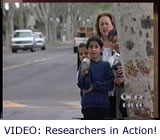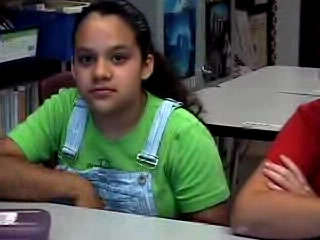

"I joined this group because I wanted to have a better and safer community than it is. I like to come to our meetings, because the more time I have to work on this, the better my community will be. . . I have changed a lot because I was very shy and now I’m really loud. I’ve done presentations in San Diego in front of 300 people. I’ve also talked to reporters from newspapers and television. I’ve talked to dignitaries from the city. I think I’ve changed because of my friends because they’re really loud too. And, I’m getting a lot of friends and my voice is getting louder." - Esme, PAR Researcher
My teaching
tools are slightly different than most. Sure, I use textbooks and pencils.
But, along with these, I use a radar gun, a computerized mapping system,
clip-boards, Polaroid cameras, video equipment and research notebooks.
My students learn in a classroom setting. But, they also use their paper
and pencils to collect data on our neighborhood streets. My name is Emily
Wolk, and I am a teacher of a remarkable group of children called the
Pio Pico Researchers. I teach using an alternative inquiry methodology
called Participatory Action-Research (PAR).
I have often been asked, “Why do I teach students about research
methodology and community-based research?” “Why do I bother
when there is so little time and so much to do?” My motivation has
become very clear to me over the last few years. I want my students to
learn basic skills. That is, I want them to learn the basic skills necessary
to transform their world. I want my students to have opportunities to
develop voice, engage in dialogue, take action and learn to reflect on
their actions. And, because I want my students to engage themselves in
their world differently, I know that teaching and learning has to look
different too.
In this website, the students and I want to present the ongoing story
of our work together. We also want to share what has been learned from
the application of critical theory and social justice to real life situations
as defined and resolved by those most affected by these issues, the students,
the community and the teacher.
Video interview with experienced PAR researchers: Outcomes of doing community-based action research
Teacher Reflections on Student PAR Learning:
I was surprised by the degree to which children made insightful comments and decisions given the necessary information, practice, environment and time. Initially, it was the research by others that encouraged me to listen to the children. I was somewhat concerned that they would not be able to make comments about issues that impacted their lives. Consequently, they would not be able to identify or study problems that they could resolve. Later, I learned to trust the students in a way I had never before. I was surprised at their depth of understanding about their peers and their community. Just as some administrators believe teachers to be unprepared to make decisions about teaching and learning, I believed the same about children. Yet, as I began to teach differently, I began to see the students differently. Freire (1996) writes, ‘The teacher cannot think for her students, not can she impose her thought on them’ (p. 58).
I realized the extent to which my students' behaviors had changed. Liliana and Lorena, who at the beginning of our student, were extremely shy and whispered their questions to me to ask on their behalf, were now set to speak at the American Educational Research Association Conference. Moreover, they were making phone calls to remind the other “off-cycle” children about the upcoming meetings. They filled out their own field trip request forms. They easily piled into my car to go out on community field trips and explained to strangers what we were researching and photographing. These two girls also formulated questions, collected and analyzed data, created diagrams, wrote speeches and interviewed community members. Every week they seemed to become more confident and more engaged.









